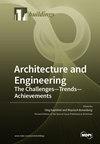基于湿热气候特征和地域建筑特色的皖中传统民居建筑微气候优化研究
IF 3.1
3区 工程技术
Q2 CONSTRUCTION & BUILDING TECHNOLOGY
引用次数: 0
摘要
本研究探讨了建筑空间、材料和结构如何影响安徽中部刘同兴隆庄的小气候,刘同兴隆庄以炎热、潮湿的气候和独特的建筑而闻名。采用定性和定量方法,包括实地监测、PHOENICS 模拟和瓢虫工具,得出以下结论:(1)建筑材料:木材可降低室内温度;天井上的玻璃屋顶可降低温度并改善风速;减少瓷砖面积可减少太阳辐射。(2) 建筑空间:楼梯间的长宽比为 1.5:1,高宽比为 2:1,舒适度最佳;庭院的长宽比为 2.5:1,高宽比为 1.5:1;穿堂的长宽比为 2:1,高宽比为 1.5:1,舒适度最佳;翼楼的长宽比为 2.5:1,高宽比为 1.5:1,舒适度最高。(3) 建筑结构:外窗高宽比为 1:1,内窗高宽比为 1.5:1,可达到最佳风速和温度;高宽比为 2:1,可达到最低温度;六边形外窗和圆形内窗可最大限度地降低风速和温度;较小的外门开口可降低室内温度,内门高宽比为 2:1,可达到最佳效果。这些发现为优化传统房屋的微气候提供了宝贵的数据和方法,具有重要的现实意义。本文章由计算机程序翻译,如有差异,请以英文原文为准。
Research on Microclimate Optimization of Traditional Residential Buildings in Central Anhui Based on Humid and Hot Climate Characteristics and Regional Architectural Features
This study examines how building space, materials, and structure affect the microclimate of Liu Tong Xinglongzhuang in central Anhui, known for its hot, humid climate and distinct architecture. Using qualitative and quantitative methods, including field monitoring, PHOENICS simulation, and Ladybug Tools, the following conclusions were drawn: (1) Building materials: wood reduces indoor temperature; a glass roof over the patio lowers temperature and improves wind speed; and reducing tile area decreases solar radiation. (2) Building space: optimal comfort in stairwells is achieved with a length-to-width ratio of 1.5:1 and height-to-width ratio of 2:1; courtyards are most comfortable with a length-to-width ratio of 2.5:1 and height-to-width ratio of 1.5:1; walk-through halls are optimal with a length-to-width ratio of 2:1 and height-to-width ratio of 1.5:1; and wings achieve the highest comfort with a length-to-width ratio of 2.5:1 and height-to-width ratio of 1.5:1. (3) Building structure: optimal wind speed and temperature are achieved with specific window height-to-width ratios of 1:1 for exterior and 1.5:1 for interior windows; the lowest temperatures occur at 2:1 ratios; hexagonal exterior and circular interior windows maximize wind speed and temperature reduction; and smaller exterior door openings lower indoor temperatures and are best achieved with an interior door ratio of 2:1. These findings offer valuable data and methods for optimizing the microclimate of traditional houses, with significant practical implications.
求助全文
通过发布文献求助,成功后即可免费获取论文全文。
去求助
来源期刊

Buildings
Multiple-
CiteScore
3.40
自引率
26.30%
发文量
1883
审稿时长
11 weeks
期刊介绍:
BUILDINGS content is primarily staff-written and submitted information is evaluated by the editors for its value to the audience. Such information may be used in articles with appropriate attribution to the source. The editorial staff considers information on the following topics: -Issues directed at building owners and facility managers in North America -Issues relevant to existing buildings, including retrofits, maintenance and modernization -Solution-based content, such as tips and tricks -New construction but only with an eye to issues involving maintenance and operation We generally do not review the following topics because these are not relevant to our readers: -Information on the residential market with the exception of multifamily buildings -International news unrelated to the North American market -Real estate market updates or construction updates
 求助内容:
求助内容: 应助结果提醒方式:
应助结果提醒方式:


